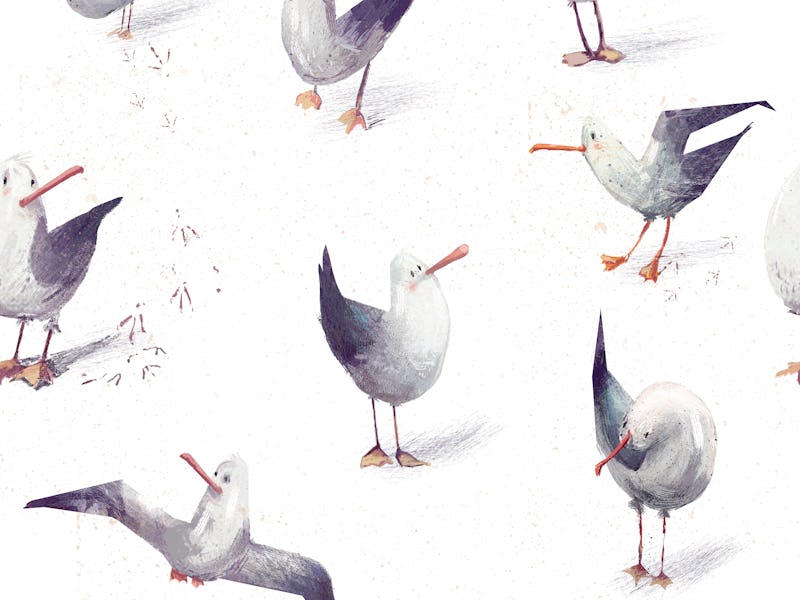Seagulls know when you're watching — study
Here's how science can help protect your fries.

Now that Labor Day weekend is behind us, beach season is officially over. But the ultimate beach menace has a year-round job pestering people who like to hang out near the sea.
Seagulls will stop at nothing to steal your fries (or your dog), but luckily, new research refines the prime technique for protecting your food from the beach birds.
When you think of a seagull, chances are you're picturing a herring gull. The gray-and-white birds perch on pink legs, peppering the shoreline and gliding above beachgoers' heads. Occasionally, they dip into the water to scoop up ocean critters — and, more than occasionally, the birds will also seek out 'prey' from the unwitting humans just trying to enjoy day at the seaside.
But researchers have a new trick to how to stop a seagull from dive-bombing your lunch: Look directly at the bird.
Yes, the way to protect yourself and your meal from these notorious scavengers is to enter into a staring contest with the enemy.
Herring gulls are aware of when a person is looking at them, according to a recent study on the birds. Scientists discovered this disconcerting ability when trying to measure how birds react to humans based on how built-up the surrounding area is. It's easier to approach an urban gull than its rural counterpart, their investigation suggests.
But in both urban and rural settings, gulls fled the scene sooner if a person was looking at them.
Researchers studied 155 gulls, including both juveniles and adults in each type of environment. The scientists approached gulls while either looking directly at them or facing toward them, while keeping their eyes to the ground.
The response to flee from a watchful human seems to be innate: Newly fledged gulls were equally likely to react to human gaze as were the older birds, the researchers found.
When rural gulls weren't being watched directly, they allowed humans to get an average of 6.5 feet closer before setting off. For urban gulls, the effect of being unwatched was even stronger; non-watching humans could get more than 8 feet closer to the city dwellers.
The research was published online on September 4 and will appear in the October 2020 issue of the journal Animal Behavior.
Refining the process — The new findings follow up on previous work that looked at how gulls respond to humans' watchful eye.
A 2019 study led by the same researcher, University of Exeter PhD student Madeleine Goumas, explored a similar idea. In that study, researchers either looked at birds or looked away. They found that looking at a bird while it ate a bag of french fries shortened the time it took for the bird to fly away.
The new study has a similar upshot, refining the method to direct eye contact versus gazing at the ground.
"In our new study, the experimenter approached while facing the gull and only changed the direction of their eyes – either looking down or at the gull," Goumas said in a statement.
"We were interested to find that gulls pay attention to human eye direction specifically, and that this is true for juveniles as well as adults – so their aversion to human gaze isn't a result of months or years of negative interactions with people."
Birds in human world — Birds are strikingly good at adapting to human environments. Gulls, pigeons, and crows have all come to live among humans, using different survival mechanisms.
Gulls have developed big brains to better navigate cityscapes and other human-dominated spaces. Meanwhile pigeons rely on a strength-in-numbers strategy, reproducing more frequently to ensure that their young will survive. Those findings appeared in a March 2020 study.
We could see more of these curious interactions in the future. Herring gulls are becoming an increasingly strong presence in urban areas, the researchers say — making it inevitable that they will interact with humans. And despite your personal feelings towards these pesky birds, ultimately, the work may help to protect them.
"The growing number of herring gulls in urban areas may make them appear more common than they really are," Goumas said.
"The species is actually in decline in the UK, and we hope our ongoing research into human-gull interactions will contribute to conservation efforts."
Abstract: With an increasing human population and expansion of urban settlements, wild animals are often exposed to humans. As humans may be a threat, a neutral presence or a source of food, animals will benefit from continuously assessing the potential risk they pose in order to respond appropriately. Herring gulls, Larus argentatus, are increasingly breeding and foraging in urban areas, and thus have many opportunities to interact with humans. We recently found that herring gulls take longer to approach food when being watched by a human. However, it is not known whether aversion to human gaze arises from experience with humans, and whether individual differences in responsiveness are a result of differential exposure. Here, we tested whether herring gulls' responses to human gaze differ according to their age class and urbanization of their habitat. We measured the gulls' flight initiation distance when an experimenter approached with either a direct or an averted gaze. Neither gull age class nor urbanization significantly influenced the effect of human gaze on flight initiation distance. However, as recently fledged juveniles responded strongly to the experimenter's gaze, aversion to human gaze may not require extensive exposure to humans to develop. Gulls in urban areas could be approached more closely than those in rural areas, consistent with findings in other species. These results indicate that gaze aversion is present early in development and that exposure to humans may influence gulls' responses to perceived risk from humans. Investigating the processes generating individual differences in responses to humans will provide further insights into human–wildlife interactions and the effects of urbanization.